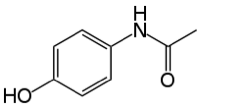Panagiotis, in order to solve the exercise, one needs to identify the relevant functional groups and explore their environment a bit.
Supposed that we're talking about "standard conditions", i.e., what is likely to happen if the dissolve/suspend the compounds in water, the situation is as follows:
In the structure of Moclobemide, we spot an amide, and - in the morpholin moiety - an ether and a tertiary amine. Amides do have a lone pair on the nitrogen atom, but due to the conjugation with the carbonyl group, the electron density on the N atom is strongly reduced, as compared to an amine. Ethers are rather lousy bases, in fact, the $pK_a$ of protonated tetrahydrofuran is as low as -2.05.
The remaining tertiary amine thus is the functional group that influences the pH: tertiary amines show a $pK_b$ around 3.3.
In Paracetamol we identify an amide (that we've already excluded as irrelevant) and a phenol group. The latter, once deprotonated, will stabilize the negative charge by resonance with the $\pi$-system (G M has already mentioned this). Therefore, phenols are far more acidic than alkanols. Consequently, the compound definitely acts as an acid.
I'm sure that you've already noticed two imide units in the case of Hexobarbital and in fact, it is possible to abstract the proton from the nitrogen atom. However, you'd need a base such as a carbonate under anhydrous conditions to deprotonate here. As a result, Hexobarbital will hardly do anything at all in water.



